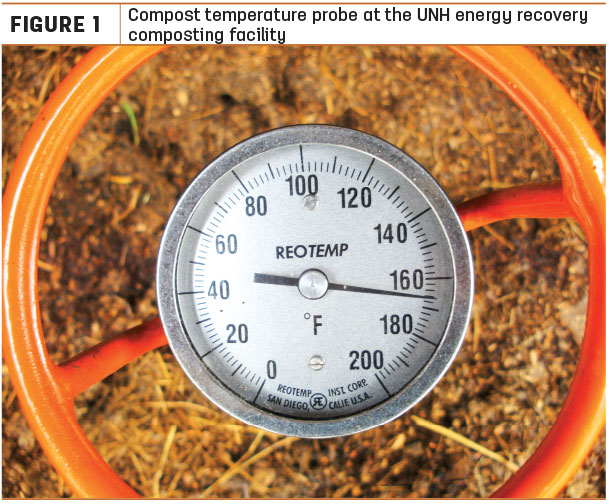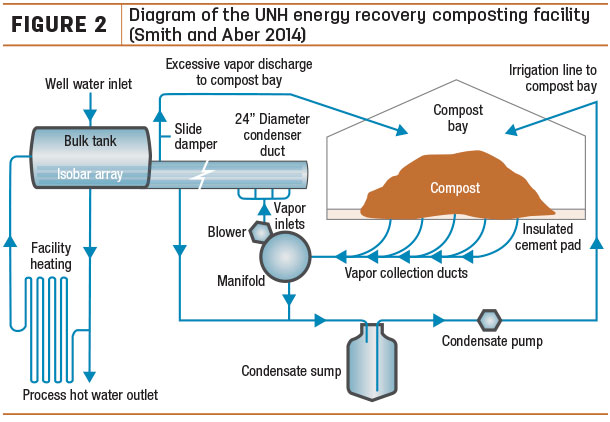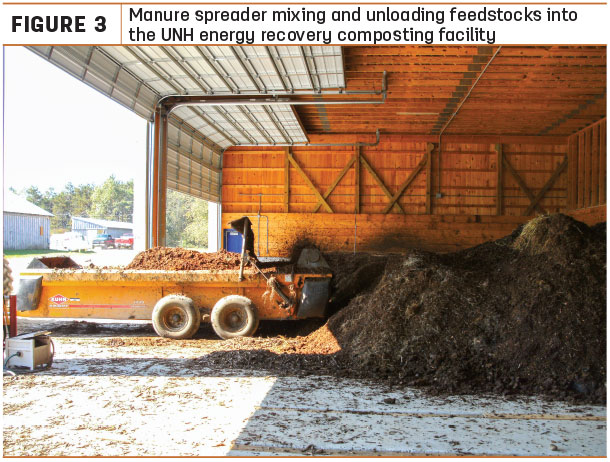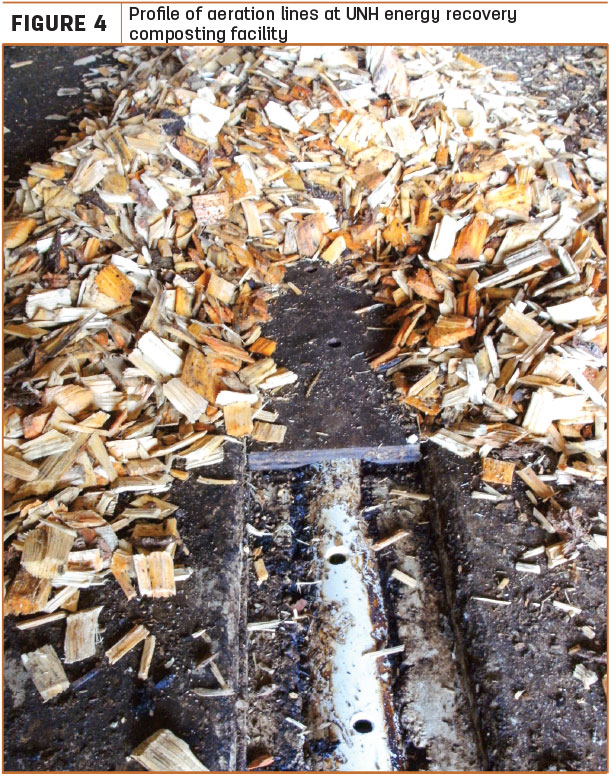Have you ever stood by a large pile of steaming dairy manure and asked yourself: How much heat energy is contained in that manure? Can that heat be captured, or are there commercially viable technologies to capture that heat? One approach to heat utilization dates back 2,000 years to rural China.
Today, researchers at the University of New Hampshire have taken a more advanced approach and designed a commercially viable method for dairy farms to capture and utilize heat from compost piles.
Energy production from composting
Energy production from composting is a direct result of aerobic micro-organisms, which produce heat as a byproduct of their metabolic activity. As such, a healthier and larger microbial population will result in faster decomposition and more energy production for capture. Ideal conditions for microbial growth include:
- Carbon-to-nitrogen ratio ranging from 25-to-1 to 30-to-1
- Moisture content maintained between 50 and 60 percent
- Oxygen concentration greater than 5 percent
- pH 6.5 to 8
- Bulk density less than 1,100 pounds per cubic yard
If these parameters are met, the micro-organisms will typically thrive, increasing compost pile temperatures beyond 150ºF (Figure 1).

It is important to note this process is not to be confused with anaerobic digestion, which utilizes anaerobic bacteria that thrive in the absence of oxygen and produce biogas as a byproduct of their metabolic activity.
The total amount of energy generated by the composting process is dependent on the specific energy of the component parts of the composting recipe. Compost recipes high in fats will produce more heat than those high in lignin, which is much more difficult for the micro-organisms to metabolize.
When looking at a wide range of composting feedstocks, an average specific energy of 19.4 MJ per kilogram dry matter has been reported. This value is like that of combusted wood, which has an average specific energy of 19 MJ per kilogram, but higher than dairy manure, which is around 16.5 MJ per kilogram.
However, since the composting process does not oxidize all of the material (decomposition is usually 20 to 40 percent), the average quantity of energy available for capture from composted manure is around 4 to 8 MJ per kilogram dry matter.
Energy recovery from composting
Three different approaches have been used to recover energy from the composting process. The first and simplest approach is direct heat utilization through convection and conduction. In these systems, which date back to ancient China 2,000 years ago, a trench is filled with composting manures and vegetation, capped with topsoil and then planted with crops.
As microbes consume the material, heat energy from their metabolic activity rises to the root zone of the crops growing overtop, allowing for a season extension of one to two months in the spring and fall. This approach was refined in the 1600s in France by encasing the hotbeds in glass enclosures and then in the 1990s by using high tunnels.
The second approach to recover energy from the composting process is through conduction alone, using within-pile heat exchangers. This approach was pioneered in the 1970s by creating a 50-ton mound of agricultural wastes with circulating tubing throughout. As the feedstocks composted and generated heat, water within the tubing was warmed from 50ºF to 140ºF at a rate of 1 gallon per minute for six months.
The heated water was used to heat a farmhouse and a winter high tunnel. Recovery rates of more than 47,500 BTU per hour were reported. This approach was further refined later by the Compost Power Network in Vermont.
The most recent and advanced approach to recover energy from the composting process is to utilize the latent heat of vaporization. Because more than 60 percent of the energy produced in a composting pile is contained within the water vapor, these systems recover considerably more energy than those using convection or conduction-based systems.
These systems use a blower to pull heated compost vapor from the decomposing feedstocks through a network of aeration pipes below the composting material. From here, the heated vapor is sent through a manifold and into a vapor-condensing heat recovery unit that warms water for hot water needs. Figure 2 illustrates this setup using a diagram from the University of New Hampshire Joshua Nelson Energy Recovery Composting Facility that our research team manages.

One of the first commercially viable non-prototype systems to utilize this method was Diamond Hill Custom Heifers in Vermont. Their energy recovery system, which is still in operation today, was built in 2006. The dairy operation utilizes a heat recovery unit to recover thermal energy from manure and spent bedding from 2,000 heifers.
The heated water is utilized for warming milk formula and for a radiant floor pad in the calf barn. Heat recovery rates of up to 200,000 BTU per hour have been reported. For reference, 1 gallon of heating oil contains roughly 138,500 BTU.
In 2012, UNH’s Agricultural Experiment Station, along with support from a private donor, constructed a commercial-scale composting facility with energy recovery at the university’s Organic Dairy Research Farm.
Heat recovery from composting was selected over anaerobic digestion, as the farm manages manure as a semi-solid to solid and has large volumes of spent pine bedding to utilize in the compost mix. Additionally, no research facility existed globally to explore this waste-to-energy strategy.
The UNH facility, which has an annual feedstock capacity of 9,600 cubic yards, is based on an aerated static pile composting design, where feedstocks (manure, spent bedding, waste feed, etc.) are mixed and then discharged onto a concrete pad with imbedded aeration lines (Figure 3 and 4).

Over these aeration lines are cover plates with wood chips, which are used to prevent the aeration system from sucking compost fines into the network.

The compost vapor pulled through the material is sent into a heat exchange unit from Agrilab Technologies, where it is used to warm 55ºF well water to 110 to 120ºF (Figure 2). This heated water is then sent to the farm’s milkhouse, where a secondary hot water heater bumps the water to 180ºF for the farm’s water heating needs.
The total project cost for the 50-by-100-foot composting facility, heat exchange unit and 50-by-50-foot concrete mixing pad was $538,000.
A detailed 70-page cooperative extension report on how the facility was designed, cost structure, cost-saving tips and instructions on how to build an on-farm commercial-scale composting system for a fraction of the cost is freely available to the public (Heat Recovery from Composting : A Step-by-Step Guide to Building an Aerated Static Pile Heat Recovery Composting Facility).
A detailed review of past compost heat recovery systems (lab scale, prototype and commercial) is also freely available to the public. Additional publications on energy recovery rates and greenhouse gas mitigation potential from these types of systems will be available to the public shortly.
Readers are encouraged to contact the UNH research team for further information about recovering heat from composting.
References omitted but are available upon request. Click here to email an editor.





